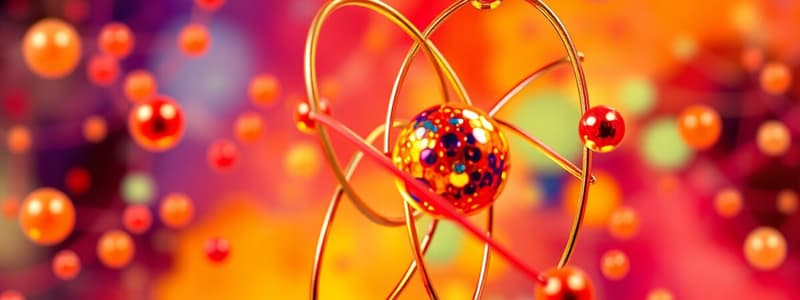Podcast
Questions and Answers
What is the primary goal of materials science?
What is the primary goal of materials science?
- To understand the relationship between material structure, processing methods, and properties (correct)
- To study chemical reactions in various compounds
- To analyze the economic impact of materials on engineering projects
- To classify materials based solely on their physical appearance
Which of the following types of materials is NOT mentioned in the introductory topics?
Which of the following types of materials is NOT mentioned in the introductory topics?
- Composites
- Biomaterials (correct)
- Metals
- Polymers
What is the primary focus of engineers when utilizing materials?
What is the primary focus of engineers when utilizing materials?
- Conducting experiments to discover new materials
- Reducing material costs in manufacturing processes
- Creating aesthetic designs for various applications
- Transforming materials into useful devices or structures (correct)
Which atomic structure element is closely related to predicting material properties?
Which atomic structure element is closely related to predicting material properties?
What aspect of materials is studied through orbital diagrams?
What aspect of materials is studied through orbital diagrams?
Which of the following is NOT a family of materials engineers commonly use?
Which of the following is NOT a family of materials engineers commonly use?
What is the main difference between metals and polymers in terms of properties?
What is the main difference between metals and polymers in terms of properties?
Which atomic particle is located inside the nucleus?
Which atomic particle is located inside the nucleus?
Who proposed the current atomic structure related to electron shells?
Who proposed the current atomic structure related to electron shells?
Which of the following methods is used to characterize materials through their structure?
Which of the following methods is used to characterize materials through their structure?
What is the approximate mass of an electron?
What is the approximate mass of an electron?
Which of the following properties does NOT directly relate to atomic structure?
Which of the following properties does NOT directly relate to atomic structure?
Which materials processing method is associated with shaping metals?
Which materials processing method is associated with shaping metals?
Which shell has the highest principal quantum number and the most energy?
Which shell has the highest principal quantum number and the most energy?
How many sub-shells are present in the n = 3 shell?
How many sub-shells are present in the n = 3 shell?
Which of the following correctly defines the number of sub-shells in the n = 2 shell?
Which of the following correctly defines the number of sub-shells in the n = 2 shell?
Which statement about shells defined by principal quantum number 'n' is accurate?
Which statement about shells defined by principal quantum number 'n' is accurate?
What is the relationship between the number of sub-shells and the principal quantum number 'n'?
What is the relationship between the number of sub-shells and the principal quantum number 'n'?
Flashcards are hidden until you start studying
Study Notes
Introduction to Materials Science
- Materials science studies the relationship between the structure of materials, the processing methods to make that material, and the resulting material properties.
- Focuses on transforming materials into useful devices or structures.
- Classification of materials includes metals, polymers, ceramics, and composites.
- Characterization techniques for materials: Infrared Spectroscopy, Scanning Electron Microscopy, X-ray Diffraction.
- Processing methods: Rolling, Deformation, Casting, Extrusion.
- Material properties of interest: Electrical, Mechanical (Strength, Hardness), Chemical (Resistance), Thermal.
Atomic Structure
- Materials are made up of atoms
- An atom is the smallest particle of a chemical element that can exist
- Components of an atom include protons, neutrons, and electrons
- Protons have a positive charge and are located inside the nucleus
- Neutrons have no electric charge and are located inside the nucleus
- Electrons have a negative charge and are located outside the nucleus
- The nucleus of an atom contains protons and neutrons, and most of the atom's mass
- The nucleus has a positive charge due to the presence of protons
Electron Shells
- Electrons are arranged in shells, defined by the principal quantum number (n)
- The lowest energy shell has n = 1, and higher shells have higher energy and higher n values
- The higher the n value of an electron, the further from the nucleus it orbits
Subshells
- Shells are split into subshells with slightly different energies
- Difference in energy between subshells is less than the difference in energy between shells
- A shell with a given n will have n subshells (e.g., n = 3 shell has three subshells)
Shells and Subshells
- The n = 1 shell has one s subshell.
- The n = 2 shell has two subshells: s and p.
- The n = 3 shell has three subshells: s, p, and d.
- The n = 4 shell has four subshells: s, p, d, and f.
Studying That Suits You
Use AI to generate personalized quizzes and flashcards to suit your learning preferences.




